Handbook of 3D Machine Vision: Optical Metrology and Imaging (Series in Optics and Optoelectronics)
暫譯: 3D機器視覺手冊:光學計量與成像(光學與光電系列)
Song Zhang (Editor)
買這商品的人也買了...
商品描述
With the ongoing release of 3D movies and the emergence of 3D TVs, 3D imaging technologies have penetrated our daily lives. Yet choosing from the numerous 3D vision methods available can be frustrating for scientists and engineers, especially without a comprehensive resource to consult. Filling this gap, Handbook of 3D Machine Vision: Optical Metrology and Imaging gives an extensive, in-depth look at the most popular 3D imaging techniques. It focuses on noninvasive, noncontact optical methods (optical metrology and imaging).
The handbook begins with the well-studied method of stereo vision and explains how random speckle patterns or space-time varying patterns substantially improve the results of stereo vision. It then discusses stereo particle image velocimetry as a major experimental means in fluid dynamics, the robust and easy-to-implement structured-light technique for computer science applications, digital holography for performing micro- to nanoscale measurements, and grating, interferometry, and fringe projection techniques for precisely measuring dynamically deformable natural objects.
The book goes on to describe techniques that do not require triangulation to recover a 3D shape, including time-of-flight techniques and uniaxial 3D shape measurement, as well as 3D measurement techniques that are not restricted to surface capture, such as 3D ultrasound, optical coherence tomography, and 3D endoscopy. The book also explores how novel 3D imaging techniques are being applied in the promising field of biometrics―which may prove essential to security and public safety.
Written by key players in the field and inventors of important imaging technologies, this authoritative, state-of-the-art handbook helps you understand the core of 3D imaging technology and choose the proper 3D imaging technique for your needs. For each technique, the book provides its mathematical foundations, summarizes its successful applications, and discusses its limitations.
商品描述(中文翻譯)
隨著3D電影的持續推出和3D電視的出現,3D成像技術已滲透到我們的日常生活中。然而,面對眾多可用的3D視覺方法,科學家和工程師在選擇時可能會感到沮喪,尤其是在缺乏全面資源可供參考的情況下。為填補這一空白,3D機器視覺手冊:光學計量與成像提供了對最受歡迎的3D成像技術的廣泛而深入的探討。該手冊專注於非侵入性、非接觸的光學方法(光學計量與成像)。
手冊首先介紹了研究充分的立體視覺方法,並解釋了隨機散斑圖案或時空變化圖案如何顯著改善立體視覺的結果。接著,它討論了立體粒子影像速度計作為流體動力學中的主要實驗手段,結構光技術在計算機科學應用中的穩健性和易於實施性,數位全息術用於微米到納米尺度的測量,以及光柵、干涉測量和條紋投影技術用於精確測量動態可變形自然物體。
本書接著描述了不需要三角測量來恢復3D形狀的技術,包括飛行時間技術和單軸3D形狀測量,以及不僅限於表面捕捉的3D測量技術,如3D超聲波、光學相干斷層掃描和3D內視鏡檢查。本書還探討了新穎的3D成像技術如何應用於生物識別這一前景廣闊的領域,這可能對安全和公共安全至關重要。
本書由該領域的關鍵人物和重要成像技術的發明者撰寫,這本權威的、最先進的手冊幫助您理解3D成像技術的核心,並選擇適合您需求的3D成像技術。對於每種技術,本書提供其數學基礎,總結其成功應用,並討論其局限性。






























